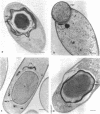Abstract
The ability of Clostridium perfringens type A to produce an enterotoxin active in human food poisoning has been shown to be directly related to the ability of the organism to sporulate. Enterotoxin was produced only in a sporulation medium and not in a growth medium in which sporulation was repressed. Mutants with an altered ability to sporulate were isolated from an sp+ ent+ strain either as spontaneous mutants or after mutagenesis with acridine orange or nitrosoguanidine. All sp0− mutants were ent−. Except for one isolate, these mutants were not disturbed in other toxic functions characteristic of the wild type and unrelated to sporulation. A total of four of seven osp0 mutants retained the ability to produce detectable levels of enterotoxin. None of the ent− mutants produced gene products serologically homologous to enterotoxin. A total of three sp− mutants, blocked at intermediate stages of sporulation, produced enterotoxin. Of these mutants, one was blocked at stage III, one probably at late stage IV, and one probably at stage V. A total of three sp+ revertants isolated from an sp− ent− mutant regained not only the ability to sporulate but also the ability to produce enterotoxin. The enterotoxin appears to be a sporulation-specific gene product; however, the function of the enterotoxin in sporulation is unknown.
Full text
PDF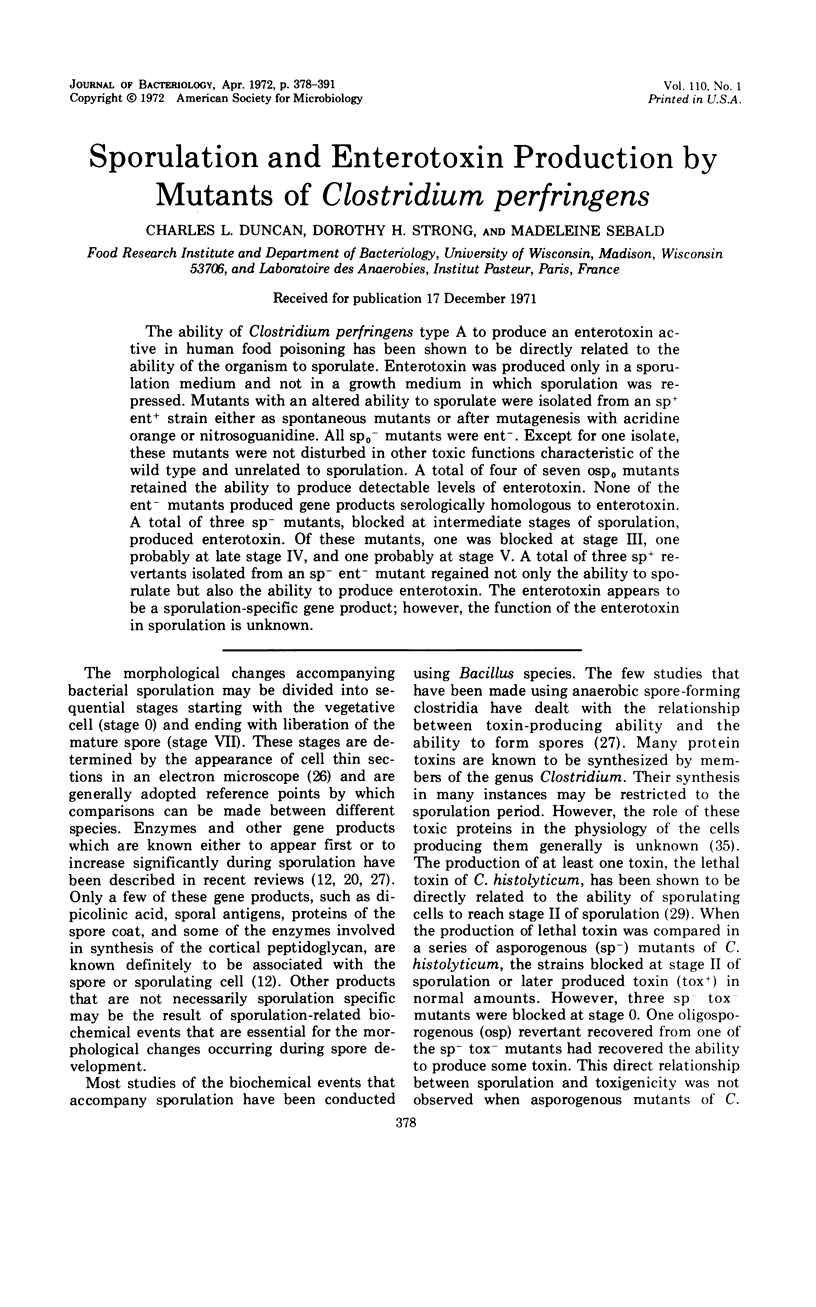
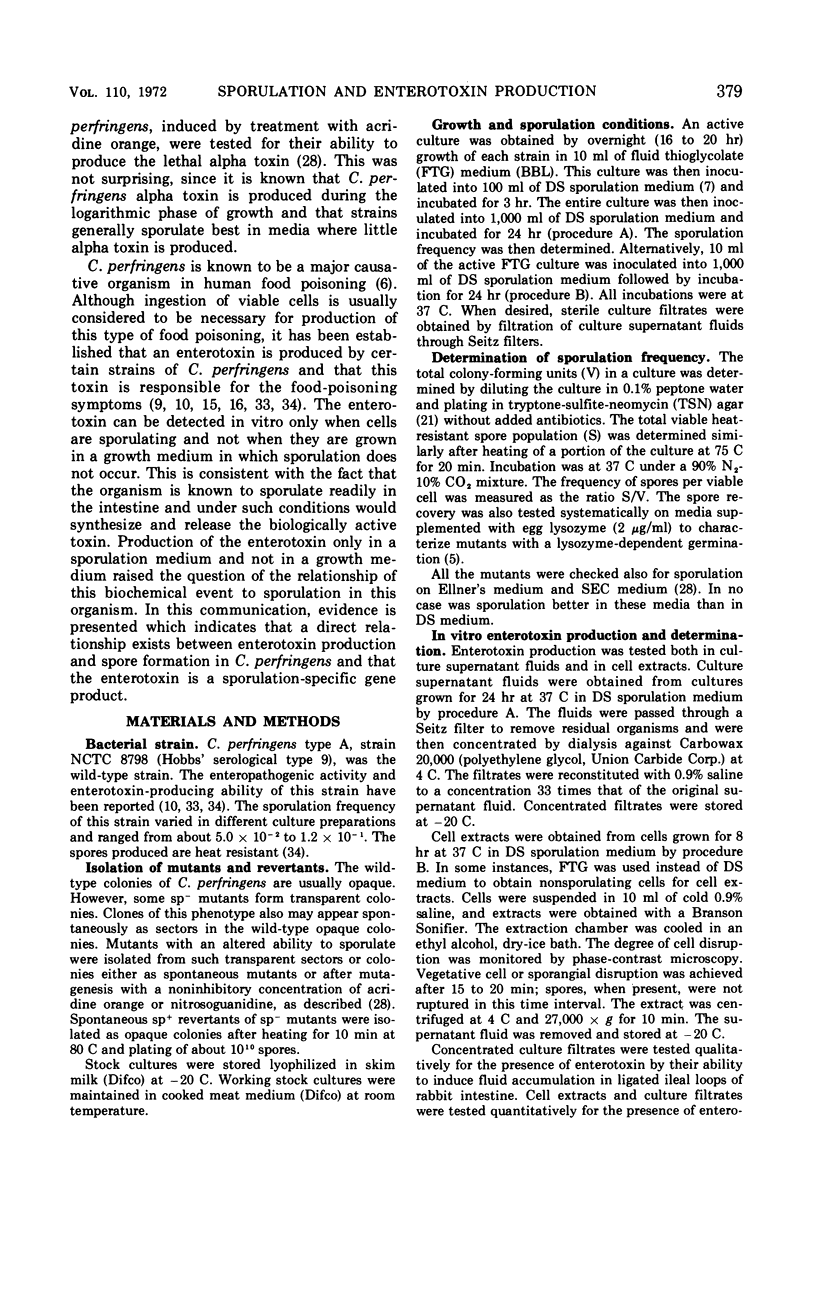
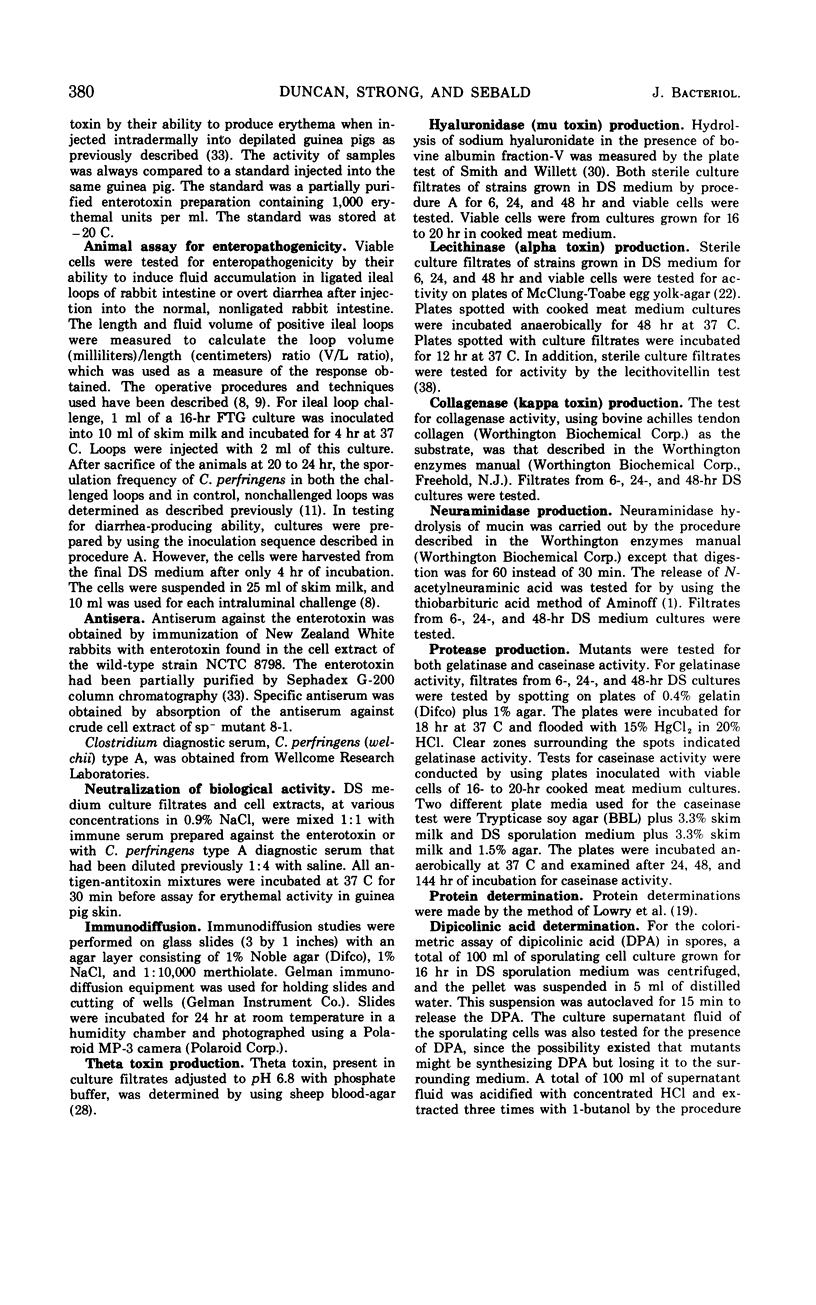
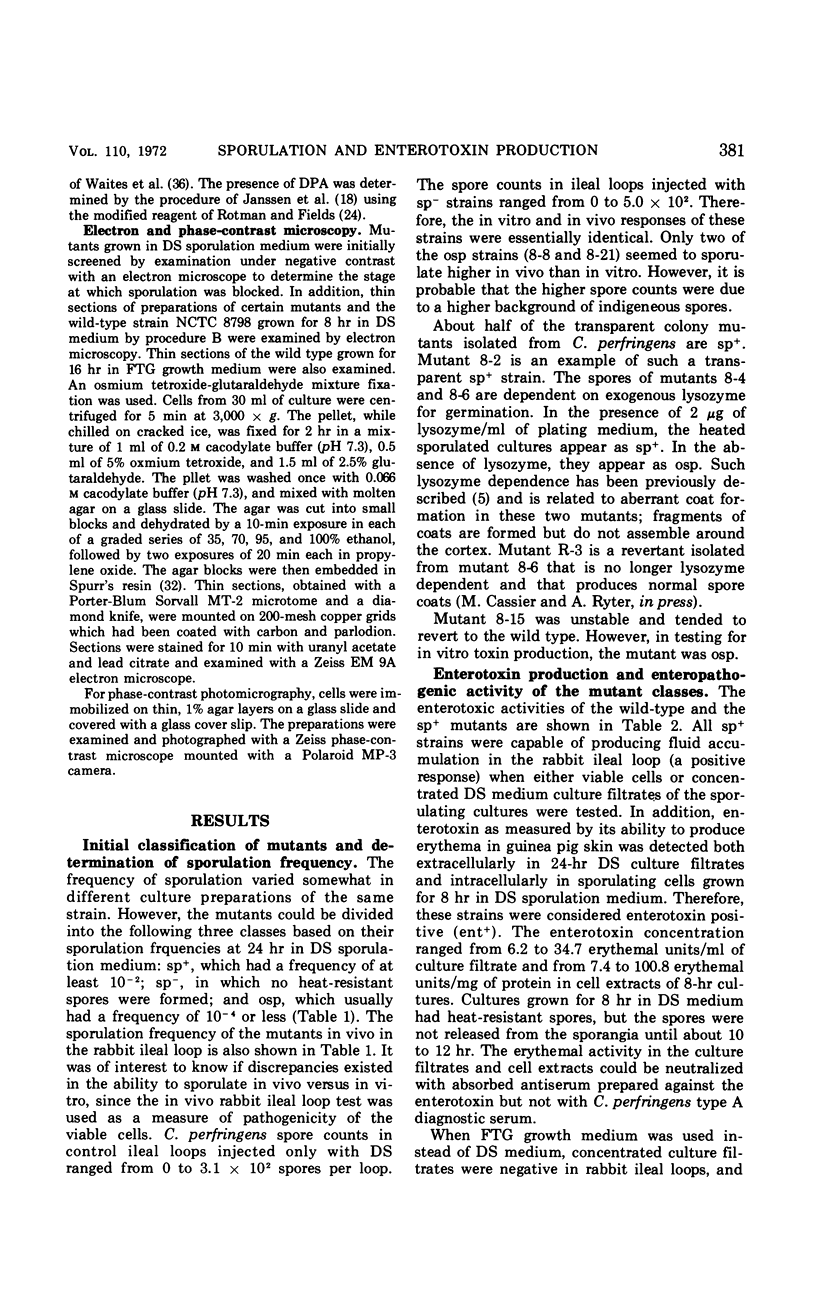
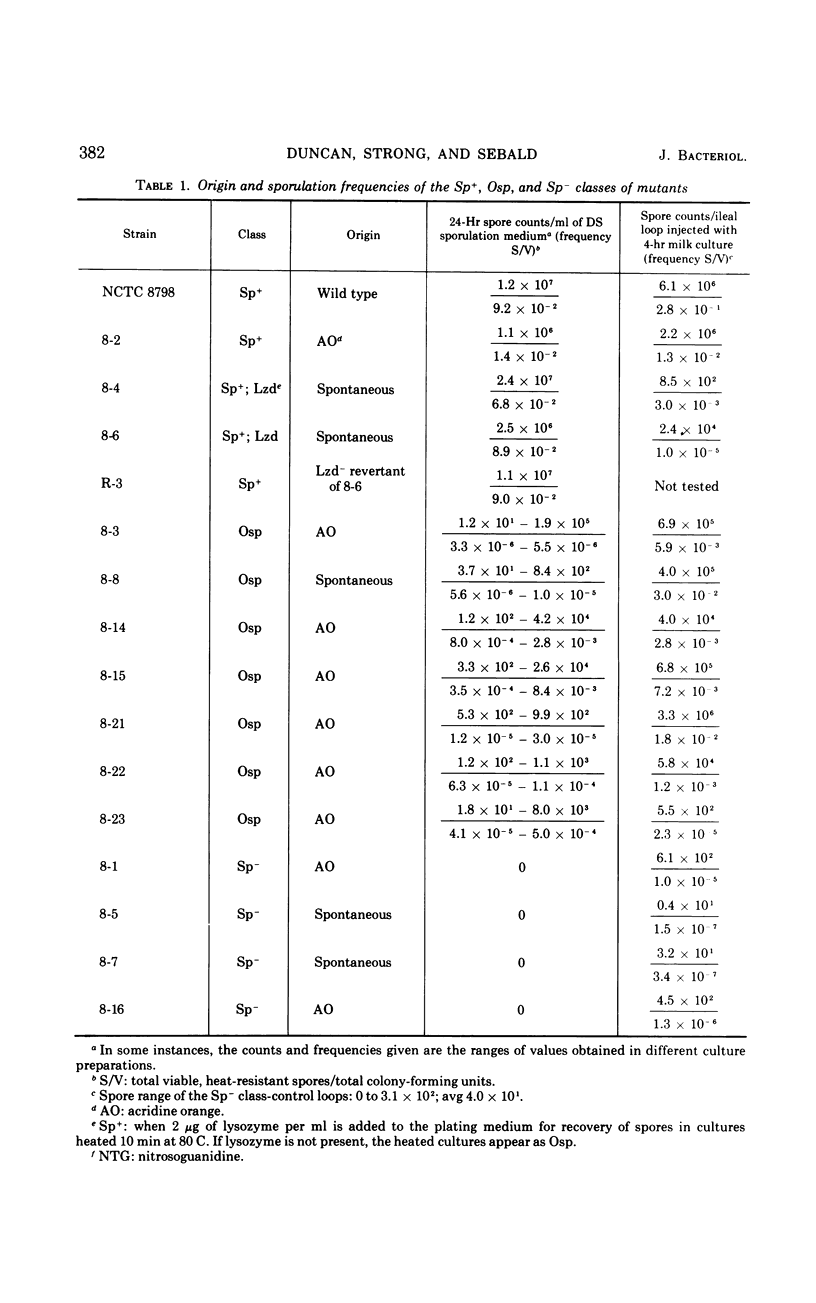
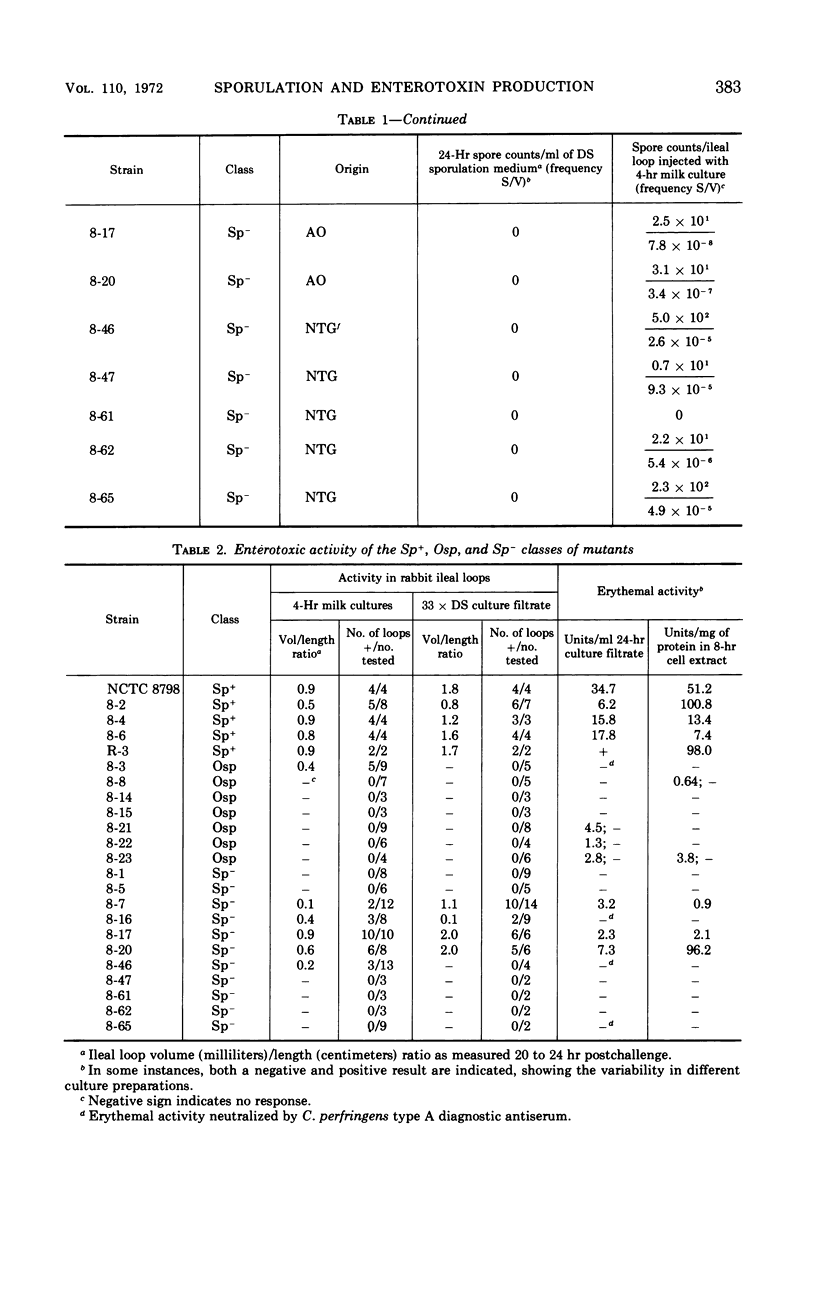
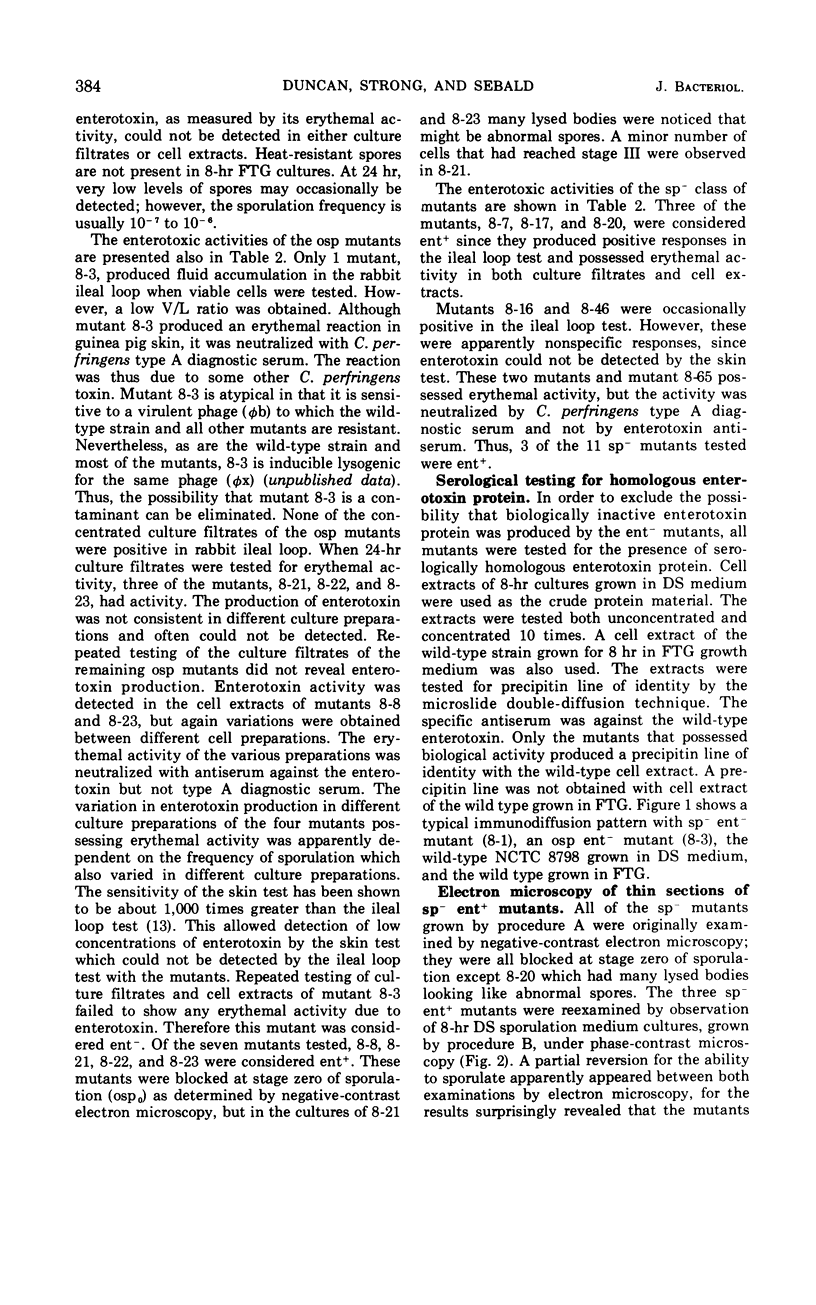
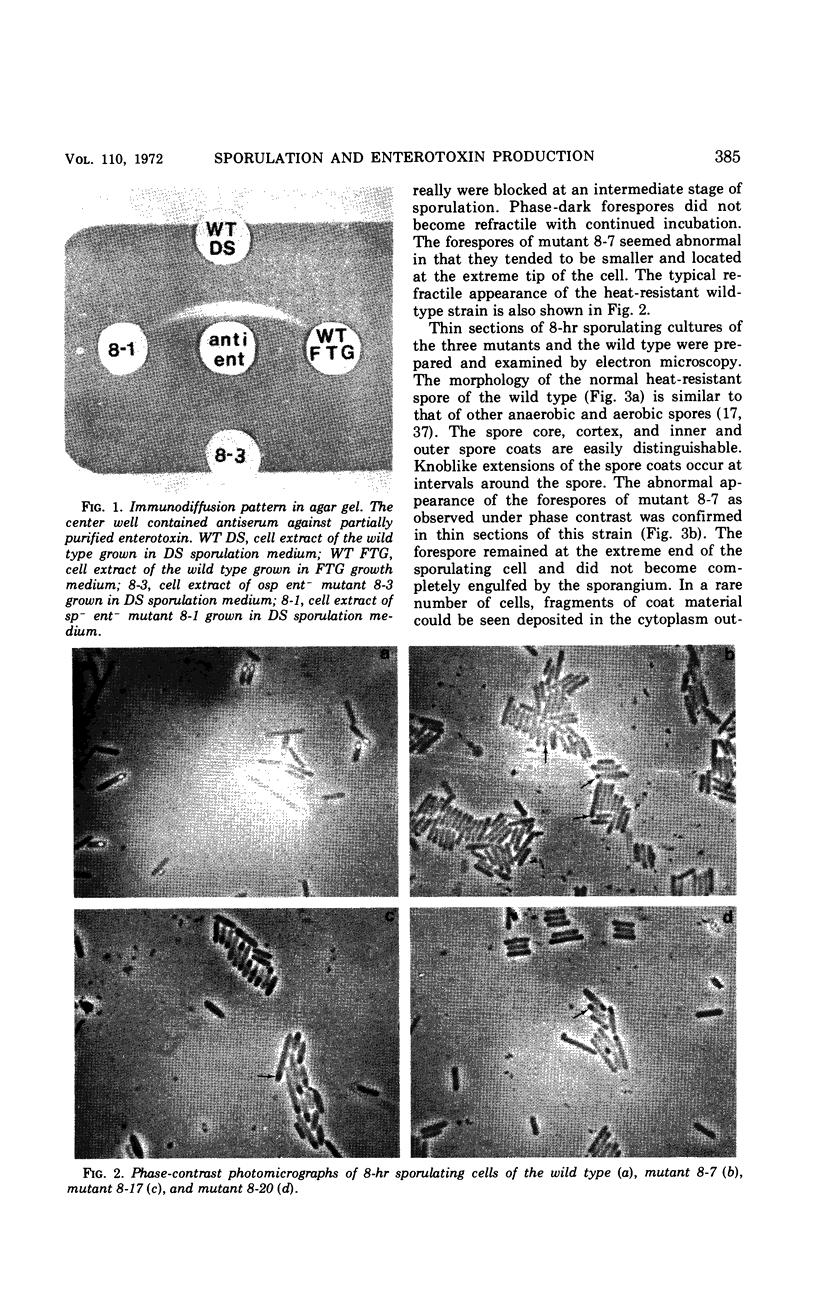
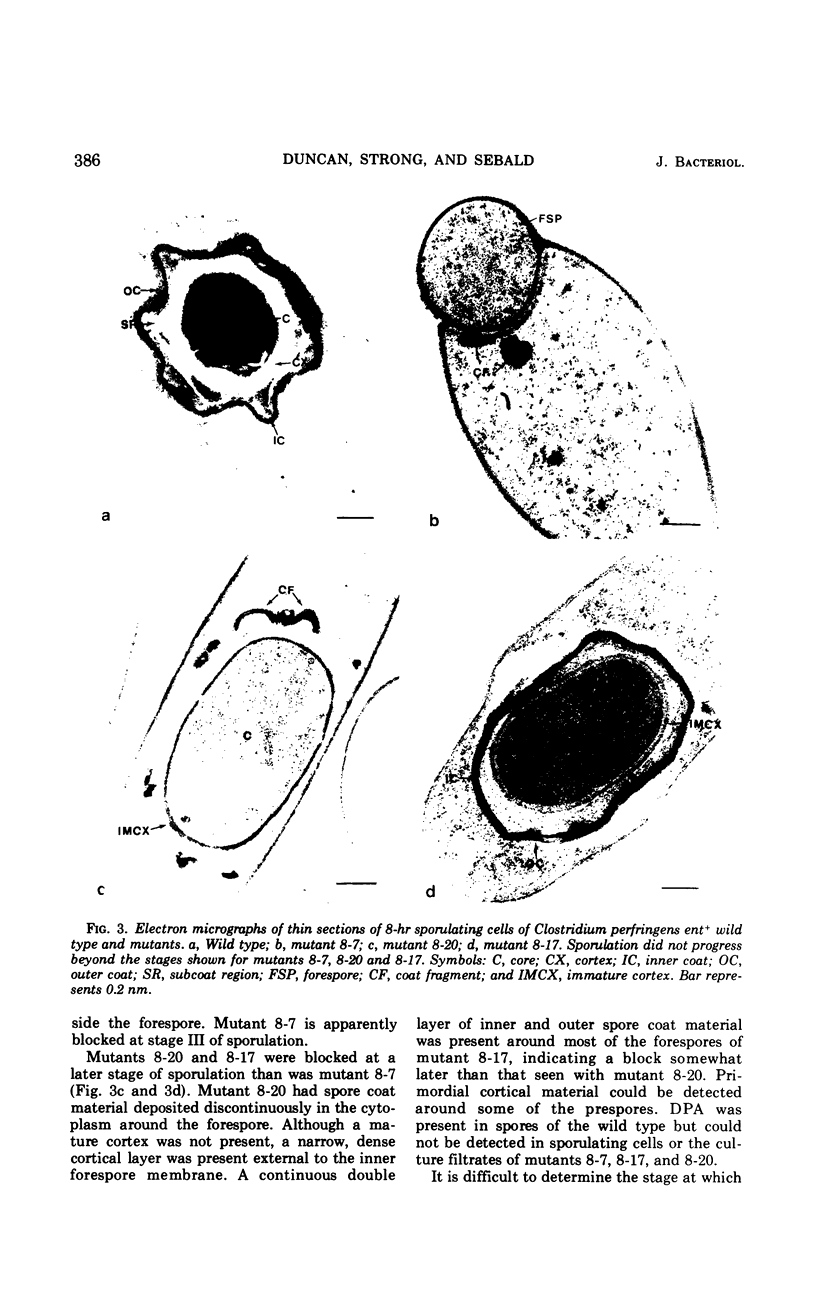
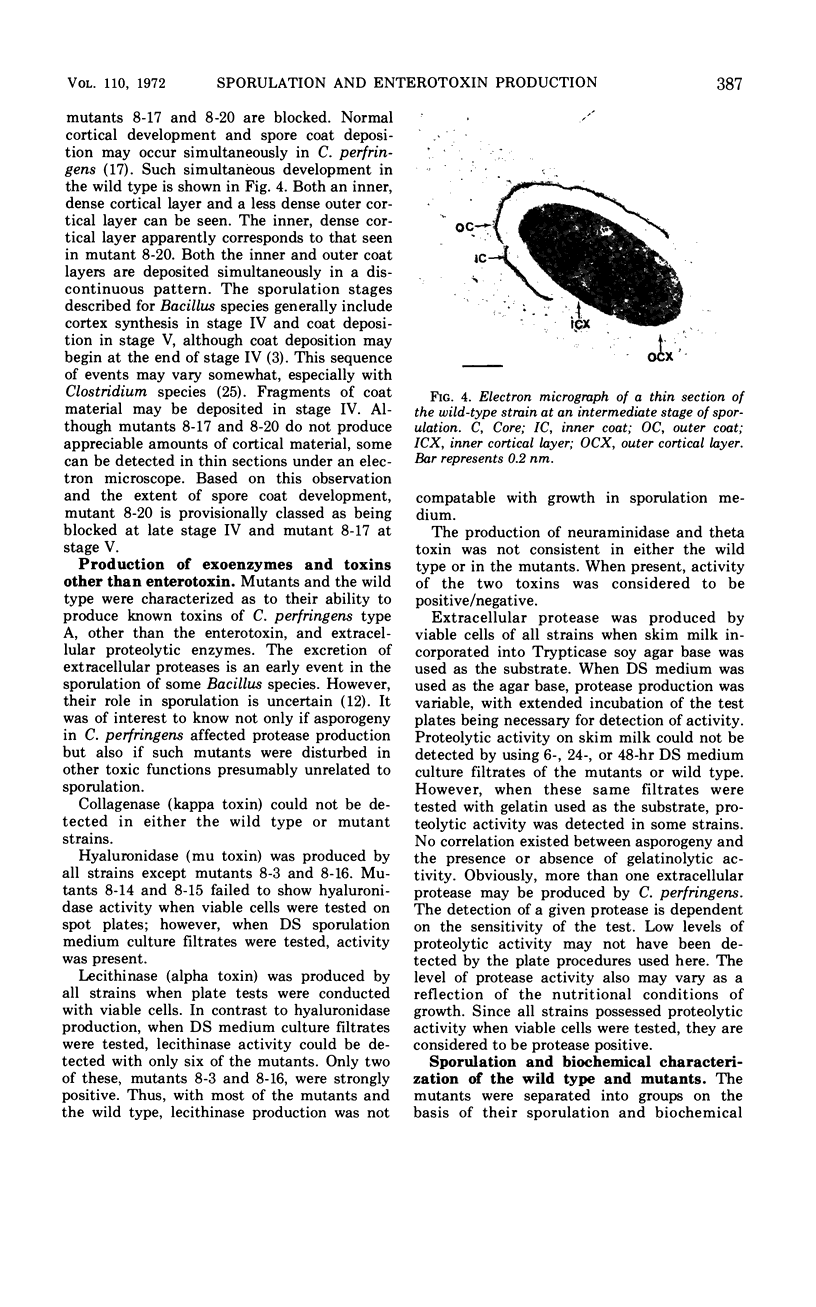
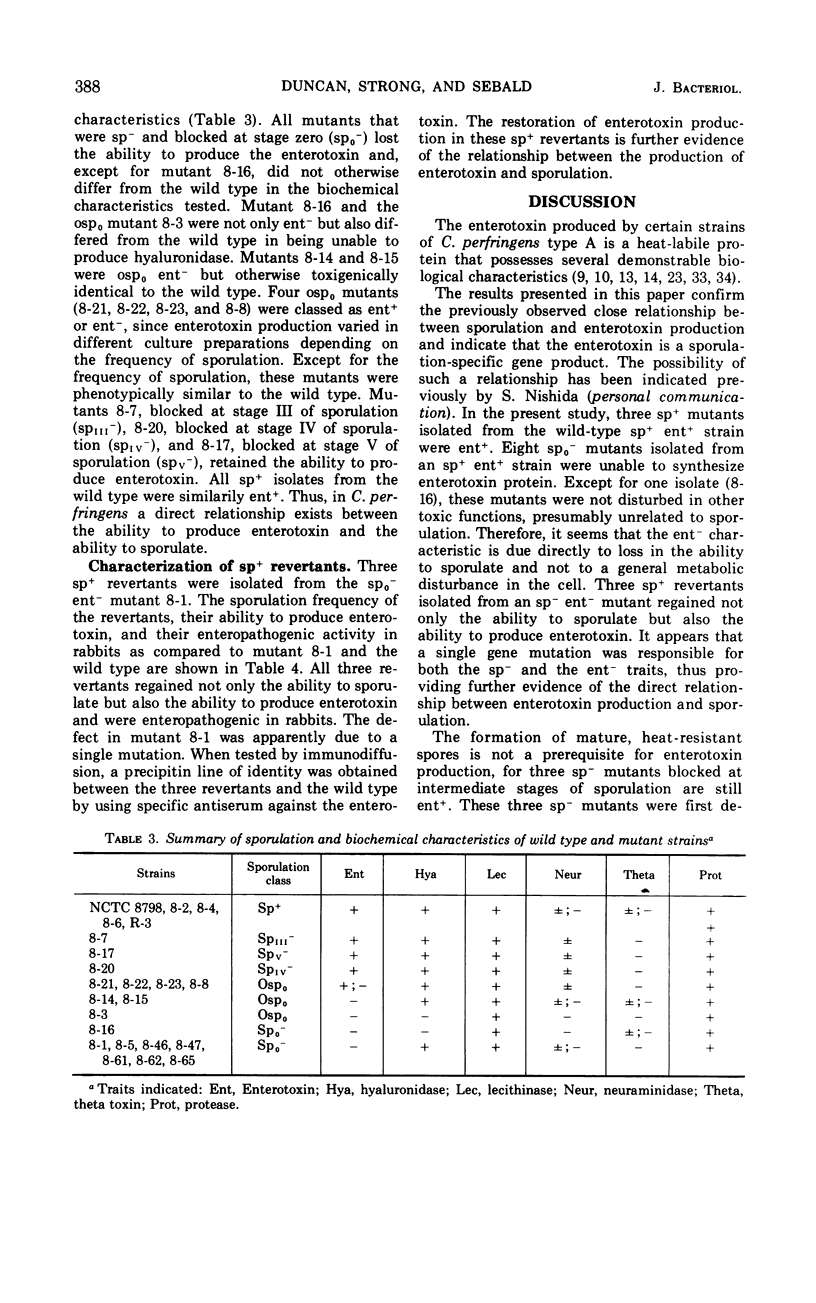
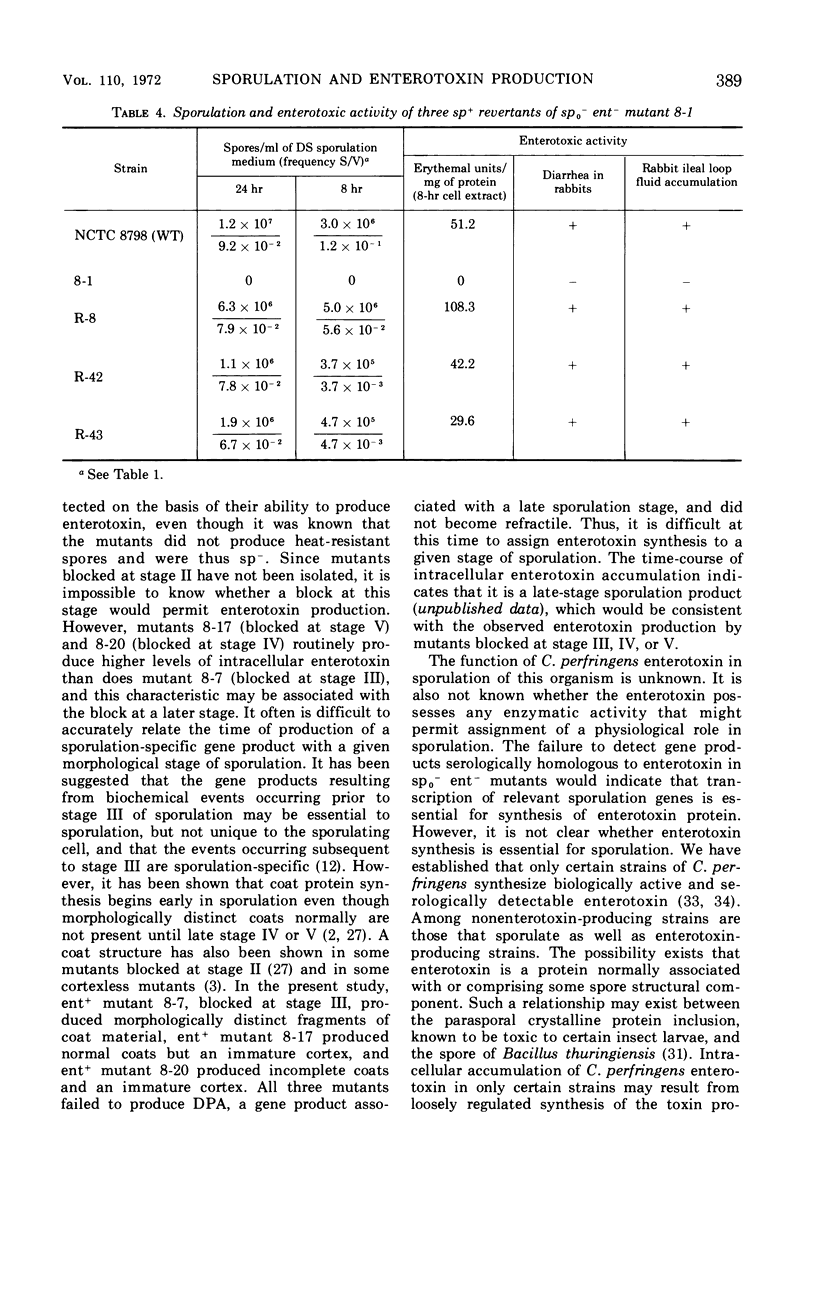
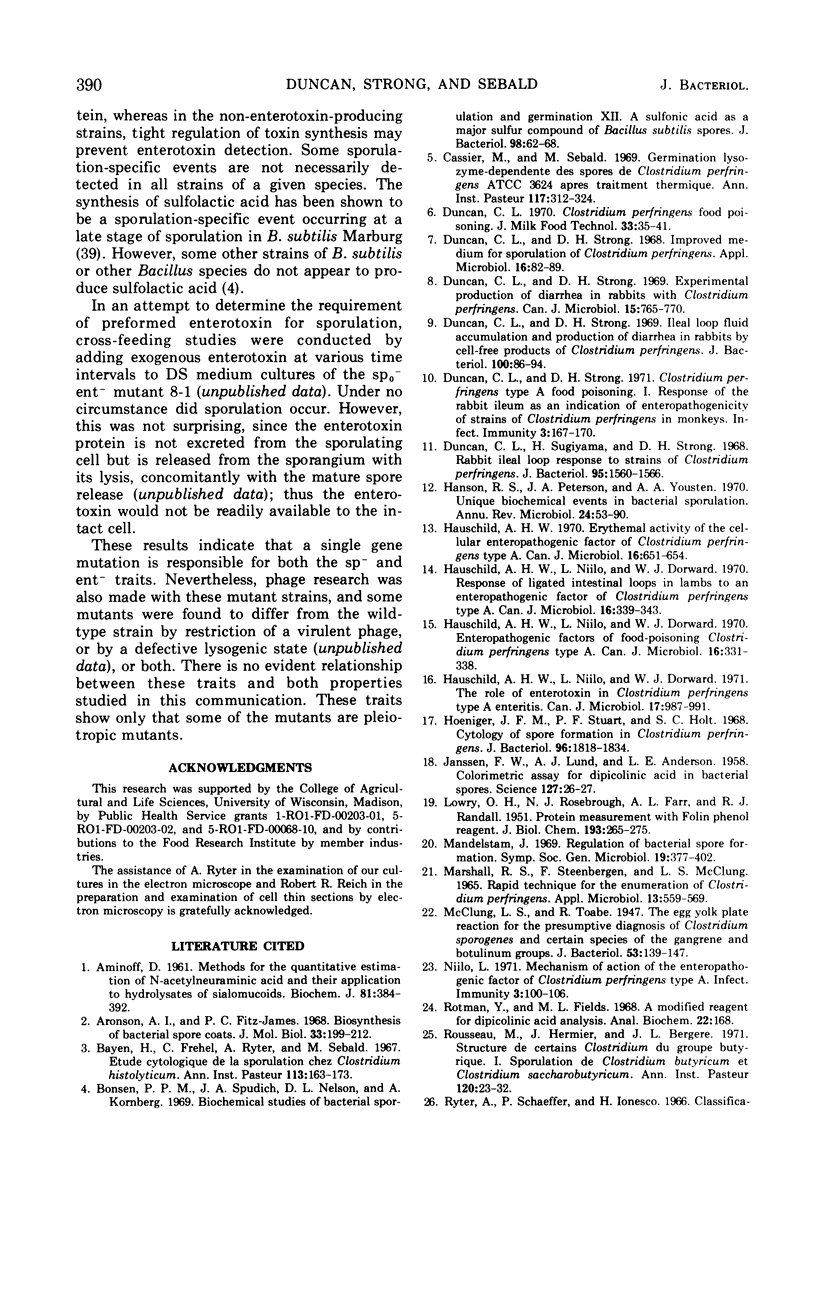
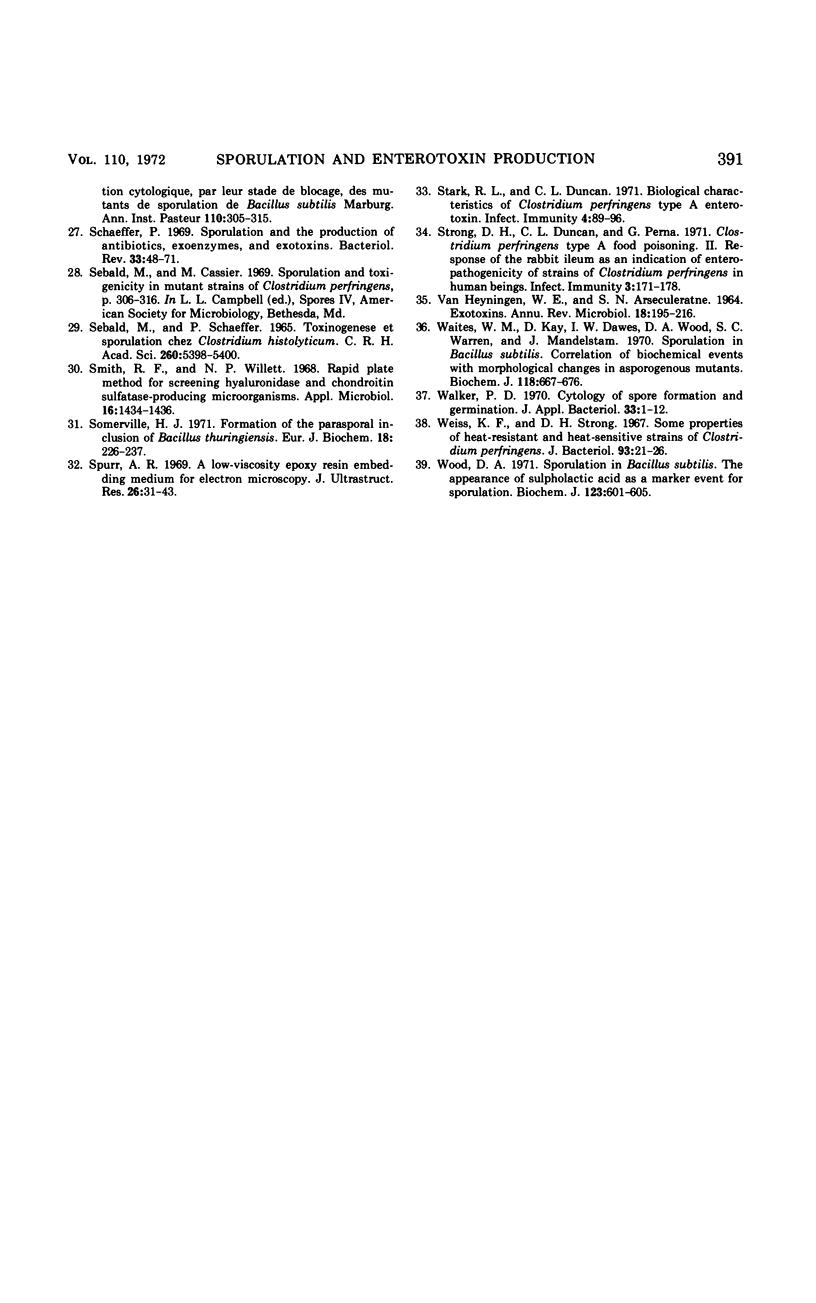
Images in this article
Selected References
These references are in PubMed. This may not be the complete list of references from this article.
- AMINOFF D. Methods for the quantitative estimation of N-acetylneuraminic acid and their application to hydrolysates of sialomucoids. Biochem J. 1961 Nov;81:384–392. doi: 10.1042/bj0810384. [DOI] [PMC free article] [PubMed] [Google Scholar]
- Aronson A. I., Fitz-James P. C. Biosynthesis of bacterial spore coats. J Mol Biol. 1968 Apr 14;33(1):199–212. doi: 10.1016/0022-2836(68)90288-x. [DOI] [PubMed] [Google Scholar]
- Bayen H., Frehel C., Ryter A., Sebald M. Etude cytologique de la sporulation chez Clostridium histolyticum. Souche sporogène et mutants de sporulation. Ann Inst Pasteur (Paris) 1967 Aug;113(2):163–173. [PubMed] [Google Scholar]
- Bonsen P. P., Spudich J. A., Nelson D. L., Kornberg A. Biochemical studies of bacterial sporulation and germination. XII. A sulfonic acid as a major sulfur compound of Bacillus subtilis spores. J Bacteriol. 1969 Apr;98(1):62–68. doi: 10.1128/jb.98.1.62-68.1969. [DOI] [PMC free article] [PubMed] [Google Scholar]
- Cassier M., Sebald M. Germination lysozyme-dépendante des spores de Clostridium perfringens ATCC 3624 après traitement thermique. Ann Inst Pasteur (Paris) 1969 Sep;117(3):312–324. [PubMed] [Google Scholar]
- Duncan C. L., Strong D. H. Clostridium perfringens Type A Food Poisoning I. Response of the Rabbit Ileum as an Indication of Enteropathogenicity of Strains of Clostridium perfringens in Monkeys. Infect Immun. 1971 Jan;3(1):167–170. doi: 10.1128/iai.3.1.167-170.1971. [DOI] [PMC free article] [PubMed] [Google Scholar]
- Duncan C. L., Strong D. H. Experimental production of diarrhea in rabbits with Clostridium perfringens. Can J Microbiol. 1969 Jul;15(7):765–770. doi: 10.1139/m69-134. [DOI] [PubMed] [Google Scholar]
- Duncan C. L., Strong D. H. Ileal loop fluid accumulation and production of diarrhea in rabbits by cell-free products of Clostridium perfringens. J Bacteriol. 1969 Oct;100(1):86–94. doi: 10.1128/jb.100.1.86-94.1969. [DOI] [PMC free article] [PubMed] [Google Scholar]
- Duncan C. L., Strong D. H. Improved medium for sporulation of Clostridium perfringens. Appl Microbiol. 1968 Jan;16(1):82–89. doi: 10.1128/am.16.1.82-89.1968. [DOI] [PMC free article] [PubMed] [Google Scholar]
- Duncan C. L., Sugiyama H., Strong D. H. Rabbit ileal loop response to strains of Clostridium perfringens. J Bacteriol. 1968 May;95(5):1560–1566. doi: 10.1128/jb.95.5.1560-1566.1968. [DOI] [PMC free article] [PubMed] [Google Scholar]
- Hanson R. S., Peterson J. A., Yousten A. A. Unique biochemical events in bacterial sporulation. Annu Rev Microbiol. 1970;24:53–90. doi: 10.1146/annurev.mi.24.100170.000413. [DOI] [PubMed] [Google Scholar]
- Hauschild A. H. Erythemal activity of the cellular enteropathogenic factor of Clostridium perfringens type A. Can J Microbiol. 1970 Aug;16(8):651–654. doi: 10.1139/m70-112. [DOI] [PubMed] [Google Scholar]
- Hauschild A. H., Niilo L., Dorward W. J. Enteropathogenic factors of food-poisoning Clostridium perfringens type A. Can J Microbiol. 1970 May;16(5):331–338. doi: 10.1139/m70-059. [DOI] [PubMed] [Google Scholar]
- Hauschild A. H., Niilo L., Dorward W. J. Response of ligated intestinal loops in lambs to an enteropathogenic factor of Clostridium perfringens type A. Can J Microbiol. 1970 May;16(5):339–343. doi: 10.1139/m70-060. [DOI] [PubMed] [Google Scholar]
- Hauschild A. H., Niilo L., Dorward W. J. The role of enterotoxin in Clostridium perfringens type A enteritis. Can J Microbiol. 1971 Jul;17(7):987–991. doi: 10.1139/m71-156. [DOI] [PubMed] [Google Scholar]
- Hoeniger J. F., Stuart P. F., Holt S. C. Cytology of spore formation in Clostridium perfringens. J Bacteriol. 1968 Nov;96(5):1818–1834. doi: 10.1128/jb.96.5.1818-1834.1968. [DOI] [PMC free article] [PubMed] [Google Scholar]
- JANSSEN F. W., LUND A. J., ANDERSON L. E. Colorimetric assay for dipicolinic acid in bacterial spores. Science. 1958 Jan 3;127(3288):26–27. doi: 10.1126/science.127.3288.26. [DOI] [PubMed] [Google Scholar]
- LOWRY O. H., ROSEBROUGH N. J., FARR A. L., RANDALL R. J. Protein measurement with the Folin phenol reagent. J Biol Chem. 1951 Nov;193(1):265–275. [PubMed] [Google Scholar]
- MARSHALL R. S., STEENBERGEN J. F., MCCLUNG L. S. RAPID TECHNIQUE FOR THE ENUMERATION OF CLOSTRIDIUM PERFINGENS. Appl Microbiol. 1965 Jul;13:559–563. doi: 10.1128/am.13.4.559-563.1965. [DOI] [PMC free article] [PubMed] [Google Scholar]
- McClung L. S., Toabe R. The Egg Yolk Plate Reaction for the Presumptive Diagnosis of Clostridium sporogenes and Certain Species of the Gangrene and Botulinum Groups. J Bacteriol. 1947 Feb;53(2):139–147. doi: 10.1128/jb.53.2.139-147.1947. [DOI] [PMC free article] [PubMed] [Google Scholar]
- Niilo L. Mechanism of Action of the Enteropathogenic Factor of Clostridium perfringens Type A. Infect Immun. 1971 Jan;3(1):100–106. doi: 10.1128/iai.3.1.100-106.1971. [DOI] [PMC free article] [PubMed] [Google Scholar]
- Rotman Y., Fields M. L. A modified reagent for dipicolinic acid analysis. Anal Biochem. 1968 Jan;22(1):168–168. doi: 10.1016/0003-2697(68)90272-8. [DOI] [PubMed] [Google Scholar]
- Rousseau M., Hermier J., Bergere J. L. Structure de certains Clostridium du groupe butyrique. I. Sporulation de Clostridium butyricum et Clostridium saccharobutyricum. Ann Inst Pasteur (Paris) 1971 Jan;120(1):23–32. [PubMed] [Google Scholar]
- Ryter A., Schaeffer P., Ionesco H. Classification cytologique, par leur stade de blocage, des mutants de sporulation de Bacillus subtilis Marburg. Ann Inst Pasteur (Paris) 1966 Mar;110(3):305–315. [PubMed] [Google Scholar]
- Schaeffer P. Sporulation and the production of antibiotics, exoenzymes, and exotonins. Bacteriol Rev. 1969 Mar;33(1):48–71. doi: 10.1128/br.33.1.48-71.1969. [DOI] [PMC free article] [PubMed] [Google Scholar]
- Sebald M., Schaeffer P. Toxinogenèse et sporulation chez Clostridium histolyticum. C R Acad Sci Hebd Seances Acad Sci D. 1965 May 17;260(20):5398–5400. [PubMed] [Google Scholar]
- Smith R. F., Willett N. P. Rapid plate method for screening hyaluronidase and chondroitin sulfatase-producing microorganisms. Appl Microbiol. 1968 Sep;16(9):1434–1436. doi: 10.1128/am.16.9.1434-1436.1968. [DOI] [PMC free article] [PubMed] [Google Scholar]
- Somerville H. J. Formation of the parasporal inclusion of Bacillus thuringiensis. Eur J Biochem. 1971 Jan;18(2):226–237. doi: 10.1111/j.1432-1033.1971.tb01235.x. [DOI] [PubMed] [Google Scholar]
- Spurr A. R. A low-viscosity epoxy resin embedding medium for electron microscopy. J Ultrastruct Res. 1969 Jan;26(1):31–43. doi: 10.1016/s0022-5320(69)90033-1. [DOI] [PubMed] [Google Scholar]
- Stark R. L., Duncan C. L. Biological characteristics of Clostridium perfringens type A enterotoxin. Infect Immun. 1971 Aug;4(2):89–96. doi: 10.1128/iai.4.2.89-96.1971. [DOI] [PMC free article] [PubMed] [Google Scholar]
- Strong D. H., Duncan C. L., Perna G. Clostridium perfringens Type A Food Poisoning II. Response of the Rabbit Ileum as an Indication of Enteropathogenicity of Strains of Clostridium perfringens in Human Beings. Infect Immun. 1971 Jan;3(1):171–178. doi: 10.1128/iai.3.1.171-178.1971. [DOI] [PMC free article] [PubMed] [Google Scholar]
- VANHEYNINGEN W. E., ARSECULERATNE S. N. EXOTOXINS. Annu Rev Microbiol. 1964;18:195–216. doi: 10.1146/annurev.mi.18.100164.001211. [DOI] [PubMed] [Google Scholar]
- Waites W. M., Kay D., Dawes I. W., Wood D. A., Warren S. C., Mandelstam J. Sporulation in Bacillus subtilis. Correlation of biochemical events with morphological changes in asporogenous mutants. Biochem J. 1970 Jul;118(4):667–676. doi: 10.1042/bj1180667. [DOI] [PMC free article] [PubMed] [Google Scholar]
- Walker P. D. Symposium on bacterial spores: I. Cytology of spore formation and germination. J Appl Bacteriol. 1970 Mar;33(1):1–12. doi: 10.1111/j.1365-2672.1970.tb05229.x. [DOI] [PubMed] [Google Scholar]
- Weiss K. F., Strong D. H. Some properties of heat-resistant and heat-sensitive strains of Clostridium perfringens. I. Heat resistance and toxigenicity. J Bacteriol. 1967 Jan;93(1):21–26. doi: 10.1128/jb.93.1.21-26.1967. [DOI] [PMC free article] [PubMed] [Google Scholar]
- Wood D. A. Sporulation in Bacillus subtilis. The appearance of sulpholactic acid as a marker event for sporulation. Biochem J. 1971 Jul;123(4):601–605. doi: 10.1042/bj1230601. [DOI] [PMC free article] [PubMed] [Google Scholar]





